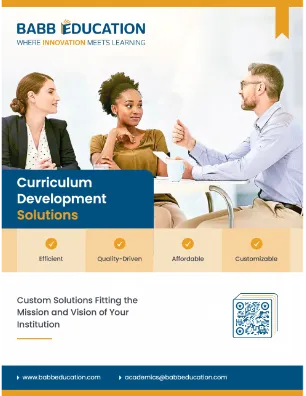Aligning course content with learning outcomes is crucial for creating a cohesive and effective educational experience for both undergraduate and graduate students.
At Babb Education, our expert instructional designers work diligently with faculty to ensure learning resources, activities, and assessments are strategically mapped to specific outcomes. This alignment enhances educational experiences for students and supports their ability to master competencies and skills associated with a particular course. In this blog, you explore the process of mapping course activities, learning resources, and assessments to learning outcomes.
Understanding Learning Outcomes
Learning outcomes are clear, concise statements describing what students are expected to know, do, or demonstrate upon completing a course or program. These outcomes serve as a guide for both instructors and students, providing a roadmap for the course and setting clear expectations. Effective learning outcomes are:
- Specific: Clearly defined and focused on particular knowledge or skills.
- Measurable: Capable of being assessed through various methods.
- Achievable: Realistic and attainable within the scope of the course.
- Relevant: Aligned with the course content and overall program goals.
- Time-bound: Able to be achieved within the course duration.
Mapping Course Activities to Learning Outcomes
To achieve mastery of learning outcomes, students participate in a variety of graded and ungraded activities. Examples include viewing lectures, reviewing learning resources, participating in discussion forums, working in groups on projects, and completing assignments. To ensure alignment, each activity should directly support one or more learning outcomes. You can effectively map course activities to learning outcomes by:
- Identifying Key Learning Outcomes: Begin by clearly defining the learning outcomes for the course. These should be aligned with the broader program goals and reflect the essential knowledge and skills students need to acquire.
- Design Relevant Activities: Develop activities designed to help students achieve the stated outcomes. For example, if a learning outcome involves developing critical thinking skills, include activities such as case studies, debates, or problem-solving exercises.
- Sequence Activities Appropriately: Organize activities in a logical sequence, building on prior knowledge and skills. This scaffolding approach ensures that students can progressively develop their competencies.
- Engage Students Actively: Ensure activities are interactive and require student participation. Active learning techniques, such as group discussions and hands-on projects, are more effective in achieving learning outcomes than passively listening to lectures.
Selecting Learning Resources to Support Outcomes
Learning resources include textbooks, articles, videos, interactive media, and other materials which support the learning process. Selecting the right resources is crucial for helping students achieve the learning outcomes. Here’s how to align learning resources with learning outcomes:
- Match Resources to Outcomes: Choose resources that directly support the learning outcomes. For instance, if a learning outcome involves understanding a specific theory, select a textbook or article that provides a comprehensive explanation of that theory.
- Ensure Accessibility: Be sure the resources are easily accessible to all students; this includes considering the format (e.g., digital, print) and ensuring the resources are available through the course platform and/or library.
- Incorporate Diverse Materials: Use a variety of resources to cater to different learning styles and preferences. This can include videos, podcasts, interactive simulations, and traditional textbooks.
- Update Regularly: Ensure resources are current and relevant. Review and update materials often to reflect the latest research and developments in the field.
Designing Assessments Aligned with Learning Outcomes
Assessments are the tools used to measure whether students have achieved the learning outcomes. These can include exams, quizzes, assignments, projects, and presentations. To ensure alignment, each assessment should be directly tied to one or more learning outcomes. Here’s how to design effective assessments:
- Define Assessment Criteria: Clearly outline the criteria for each assessment, ensuring they reflect the learning outcomes. For example, if a learning outcome involves analytical skills, include assessments requiring analysis, such as essays or research projects.
- Use a Variety of Assessment Methods: Employ different types of assessments to measure various competencies. This can include multiple-choice quizzes for factual knowledge, essays for critical thinking, and projects for practical application.
- Provide Formative and Summative Assessments: Use formative assessments (e.g., quizzes, draft submissions) to provide ongoing feedback and help students improve. Summative assessments (e.g., final exams, projects) should evaluate the overall achievement of learning outcomes.
- Ensure Transparency and Fairness: Clearly communicate the assessment criteria and grading rubrics to students; this transparency helps students understand what is expected of them and ensures fair evaluation.
Best Practices for Undergraduate Courses
Undergraduate courses often focus on foundational knowledge and skills. Here are some best practices for aligning content with learning outcomes in undergraduate courses:
- Simplify and Clarify: Use clear and straightforward language when defining learning outcomes and instructions.
- Encourage Exploration: Design activities encouraging students to explore and discover new concepts.
- Provide Scaffolding: Offer structured support and gradually increase the complexity of activities and assessments.
- Foster Engagement: Use interactive and engaging methods to maintain student interest and motivation.
Best Practices for Graduate Courses
Graduate courses typically involve advanced and specialized knowledge. Here are some best practices for aligning content with learning outcomes in graduate courses:
- Focus on Depth and Complexity: Develop learning outcomes reflective of higher-order thinking skills and deep understanding.
- Promote Research and Inquiry: Include activities and assessments involving research, critical analysis, and synthesis of information.
- Encourage Autonomy: Provide opportunities for students to take ownership of their learning through independent projects and self-directed study.
- Foster Professional Development: Align learning outcomes with professional skills and competencies relevant to the field.
Aligning course content with learning outcomes is essential for creating a cohesive and effective learning experience. By following best practices, and continually refining the alignment process, instructional designers and faculty can create dynamic and meaningful learning environments, preparing students for academic and professional success.
At Babb Education, our expert instructional designers are dedicated to helping faculty design courses that meet these goals, enhancing the educational experience for both undergraduate and graduate students.
Contact Babb Education today to learn more about how we can assist you in aligning your course content with learning outcomes. Together we can create a transformative educational experience for your students!



